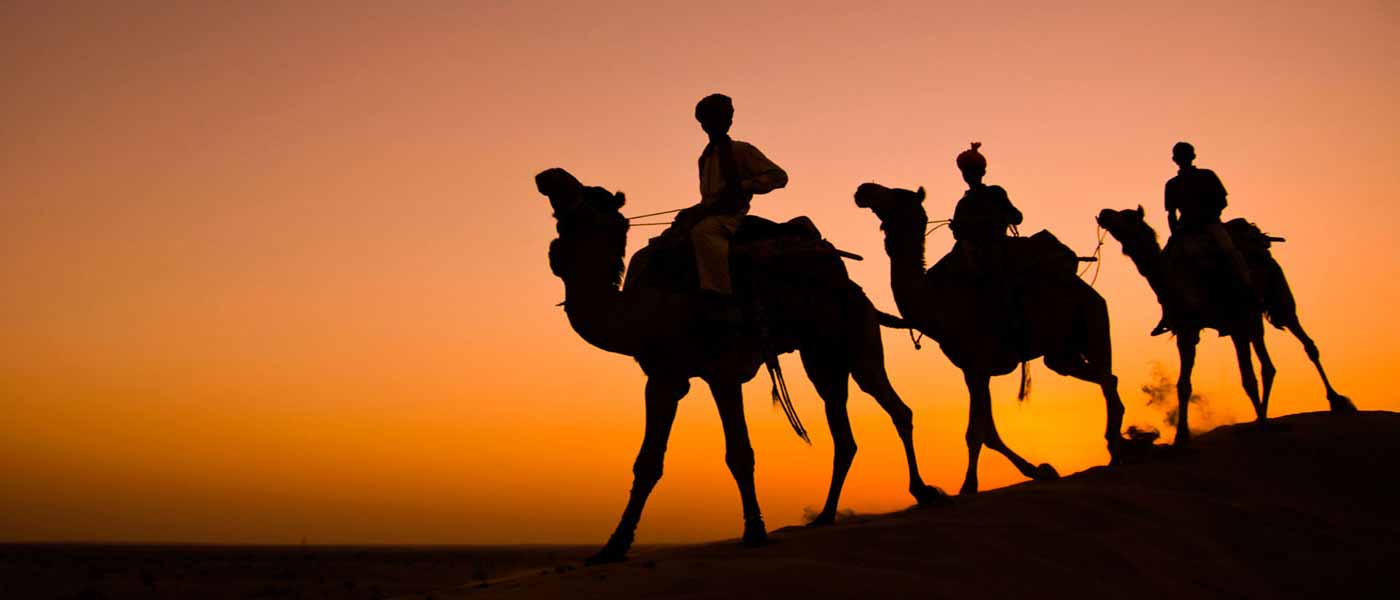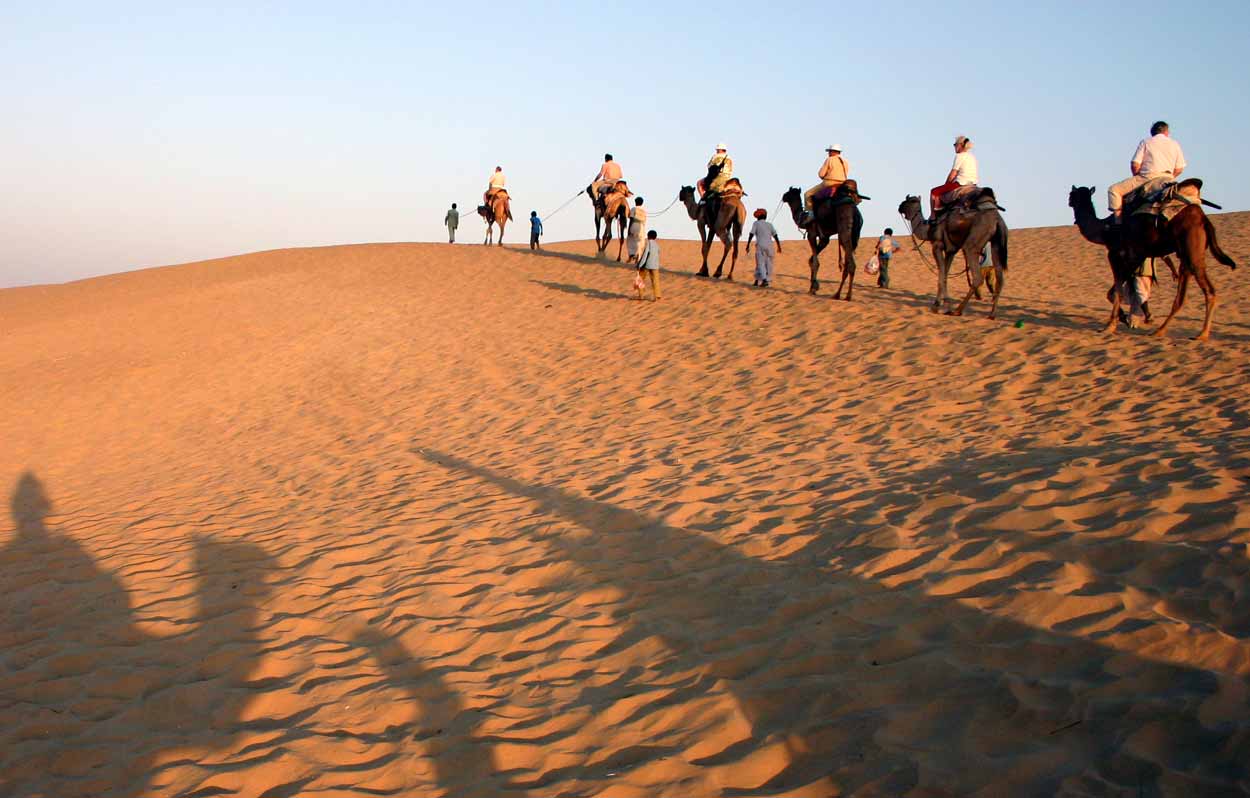
While wandering around Rajasthan, you should absolutely make the trip out to Jaisalmer, near the Pakistan border. Here you can be in a city that seems like it’s made only out of the sand, with a huge fort towering over it, and go out on a camel safari in the Thar Desert. Here are tips for Jaisalmer, and here some tips for the camel safari.
Best Time to Visit: November to March is the ideal time to visit Jaisalmer. Sightseeing and other outdoor activities like camel ride, desert safari are more enjoyable during this time as the maximum temperature does not go beyond 24 degree Celsius. Evenings are cooler and at night, the temperature can further drop down to 7 or 8 degree Celsius in the desert area, especially in the months of December and January.
April to August: These months are the hottest in the year as they constitute the summer season. Temperatures can vary from 42 to 25 degree Celsius during this time.
Places to Visit
Jaisalmer Fort is open on all days. Jaisalmer Fort is famously known as Golden Fort of Rajasthan. It is famous for photography, history & architecture. It was constructed by Raja Jaisal, Rajput ruler in the year 1156 AD. It ranks amongst the largest forts in the world. The golden and yellow mixed sandstone offer magical look to the Fort. Rising from the desert sands like a mirage, the fort is a real sight with its 99 turrets during night. The Fort stands tall and proud displaying the magic of Rajasthani architecture.
Bada Bagh open on all days means ‘Huge Garden’. Maharawal Jait Singh’s period saw its construction, which was in the beginning of 16th century. The garden served as a memorial where the nobles and their families were cremated. The garden offers a stunning view. The place is isolated. If you visit the place during sunrise and sunset, you are guaranteed of beautiful moments, which you cannot avoid clicking.
Patwon Ki Haweli is located in the main city. This massive five-storied construction has five intricately decorated huge suites. The large corridors and the decorated walls are excellent representations of the art form that prevailed. The entire construction is made of yellow sandstone. The grandeur and the architecture of the monument add immense value to the cultural heritage of the city. Out of the five havelis, one is converted into a museum. The third haveli houses the works of local craftsmen of the bygone era.

Sam Sand Dunes open on all days. To have a feel of the desert, you need to undertake Desert Safari. Sam Sand Dunes is the ideal location to set off for the Desert Safari. You will love the safari on camelback that would take you along crests and troughs and you could watch the picturesque sunset on the desert. Jeep safaris are available as well. Desert festival is organized in the months of February and March. If you are around this time, you would not want to miss the folk dances, camel races and other cultural events conducted here.
Things to Do at Sam Sand Dunes
- Desert Camping.
- Desert Safari.
- Paragliding and other adventure sports.
- Camel rides.
- A visit to the nearby Desert National Park and Sanctuary.
Gadisar Lake Open on all days. Gadisar Lake is located a kilometer away from the fort. It was constructed by the first ruler of the land, Raja Rawal Jaisal and later reconstructed by Maharawal Garsi in the year 1367 AD. The people of the desert city depended on this tank for their water needs. You will find temples, Holy shrines and Chattris around the banks of this lake. The artistically carved entrance made of yellow sandstone offers breathtaking view.
Nathmal Ki Haveli Open on all Days. Nathmal Ki Haveli. Apart from its extraordinary outer carvings, this haveli is known for its beautiful interiors filled with paintings and equipped with modern facilities. An amalgamation of Islamic and Rajputana architecture, Nathmal Ki Haveli is well justified as being one of the most beautiful haveli in Jaisalmer.
Jain Temples Open on all days. Located inside Jaisalmer Fort, Jain temples are a series of temples dedicated to Jain Tirthankaras and can be traced back to the 12th century. The temples are are known for their distinctive architectural style modelled after the Dilwara temple of Mt. Abu. Beautifully carved and well interconnected, these temples are a vision to behold and are completely made up of yellow sandstone.
Salim Singh Ki Haveli Open on all Days. Among all the havelis in Jaisalmer, Salim Singh Ki Haveli is known for its distinctive and eye-catching architecture. It has 38 balconies with their own distinctive style of architecture and a peacock shaped roof. This haveli provides a good glimpse in the past and the photographs taken here would be awe inspiring.
Kuldhara Open on all days. An abandoned ghost town, Kuldhara was once a prosperous town occupied by Paliwal Brahmins. The reasons for why a whole city was abandoned within a night is not clear but the popular belief holds the then state minister Salim Singh responsible for the same. The minister wanted to marry the village chief’s daughter and therefore delivered an ultimatum to the village chief to accept his demands or let the whole community face dire consequences. Rather than giving in to the minister’s demands, the whole village decided to move away. Before leaving, they cursed this place to never have any kind of human settlement and this has been proven true to this date. Visit Kuldhara to get a glimpse of the past and get spooked by its tales.
Longewala War Museum- The Jaisalmer War Museum located 10 km short of Jaisalmer on the Jaisalmer – Jodhpur Highway was conceived by Lieutenant General Bobby Mathews, AVSM, VSM, General Officer Commanding, Desert Corps and constructed by the Desert Corps of the Indian Army. The Jaisalmer War Museum was conceptualised to display India’s rich military history and showcase real war efforts as they happened in the past. The Jaisalmer War Museum aims to promote greater awareness of the sacrifice made by heroes of the Indian Army, in particular, and Indian Armed Forces in general.